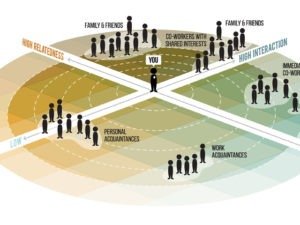If company culture is defined by relationships (how people work together to deliver results), and critical working relationships are increasingly multi-generational, then you can drive culture alignment by adopting communication preferences that appeal to different generations.
In a sense, it’s never been easier to communicate with others. We now have more channels than ever to reach out to our colleagues. But with the abundance of options comes the burden of choice, complicated by generational channel preferences—one size does not fit all. Add to that the growing number of generations represented in a work force and the complexity grows. At Senn Delaney, we talk to business leaders all the time who understand building relationships is important for culture, but can’t quite figure out how to navigate the choices and preferences to connect to their multi-generational workforce.
Every employee is unique, but to speak in generalized terms for the sake of an example, the contrast in preferences can be stark. Baby Boomers often prefer stability in their work environment. They like traditional communications such as in person meetings and memos. But millennials came into the workforce alongside the social media revolution. They prefer more flexibility in their communication—why talk in person when you can say everything over an instant messenger program?
This problem is made even more complicated by our expanding work-life expectancy. Millennials may hold the dominant share of the labor force, but Boomers and the Silent Generation are working for longer than anyone expected. At the same time, Gen Z is just beginning to enter the job market while Gen X isn’t going anywhere, anytime soon. As a result, there are now an unprecedented five generations working alongside each other, and the age gap between our oldest and youngest workers is the widest it’s ever been.
Creating a standardized communications strategy for such a diverse employee population can feel like an impossible task. How can you expect employees to build relationships when their communication preferences are ostensibly incompatible and the physical location of work is no longer confined to a centralized office?
White Paper: How Relationships Shape Engagement and Culture
Building relationships across different generations in the workplace
Company culture prospers when it unifies diverse employees and facilitates decision-making based on a consistent understanding of company purpose and strategic objectives. Simply put, if you can’t communicate effectively with your employees—and if employees can’t communicate effectively with each other—you can’t deliver the key messages that link the importance of their work to organizational strategy. Culture will suffer as a result because the relationships that form will be transactional in nature. They won’t inspire employees to collaborate, innovate, or provide discretionary effort on behalf of the company’s goals.
Some leaders will resign to the situation and chalk this communication disconnect up to “irreconcilable generational differences.” They forget that, on occasion, complicated problems can have simple solutions.
If you want to open up communication between generations, build professional relationships, and create culture alignment, just listen to your employees. Ask them what their communication preferences are, and leverage their preferred channels to build relationships and reinforce your culture.
Yes, it’s really that simple. We often lose sight of the fact that communication is a two-way exercise. If we don’t know if they’ve received the message, the communication isn’t complete. So just ask. It’s not a communication, it’s a dialogue.
As an entrepreneur and corporate executive, I’ve learned firsthand the importance of being involved in the onboarding process. It’s a valuable time to learn the communication preferences and expectations of new hires while setting realistic expectations of how we work together to achieve results. Our goal as leaders is to shift employee perceptions of work, and that means acting on the information they give us through solicited and unsolicited feedback channels. In my work, we capture the culture and communication preferences new hires give us in a matrix, and design our communications channels to reach them and reinforce the importance of their voice from day one.
Leaders must be the ones spearheading this initiative because it’s a humanizing process, connecting them with every employee up to the front line. It shatters the perception that leaders stay on the “executive floor,” and emphasizes their role as part of the team.
Leaders who take a proactive role in listening to their employees from the start understand that high-performing cultures are built on relationships that extend beyond a worker’s reporting structure. They’re built on relationships based on communities of common interests. Understanding how employees communicate is the first step to discovering these interests, and bringing employees together across departments to create a less fragmented workforce.
What does culture alignment across generations look like?
Accommodating communication preferences doesn’t mean employees won’t have to compromise. The key is to ensure the compromise is never exclusionary.
The “easy” thing to do would be to force everyone to use one default channel to accommodate you. But if relationships are your priority, it’s not about you. It’s about engaging your employees and teams in the ways they feel comfortable. Be inclusive of all communication channels, because each channel is a valuable relationship-building tool.
What you’ll find is the resulting environment is one of openness and transparency. Where employees can question the status quo (“Do we really need to have this meeting?”), and still comfortably work within the confines of their environment. And when employees feel that comfort, trust flows through the organization and strong work relationships begin to form.
The connections employees and leaders make across generations create alignment on culture, and motivate employees to deliver on the company’s key objectives. A multi-generational workforce empowered by relationships and culture operates beyond merely policies and processes; employees strive to put that extra amount of effort in because they want to do it. But the company can’t get to that point unless leaders understand, and embrace, how the different generations in the workplace build relationships and prefer to communicate.
Barbara Porter is an executive director at EY and works with clients to integrate all levers of engagement to maximize results. She has developed and refined an outcome focused model that begins with building an intentional culture that aligns business priorities with those of employees and customers. Using this model, she has led teams, colleagues, and clients to deliver superior performance that contributes to bottom line results and sustainable growth. To accomplish this, she works with cross-departmental leaders to break down silos and integrate and align employee engagement and customer experience strategies across the entire enterprise. She has published several articles for industry publications, including “Employee Engagement: Its Impact on Profitability and the Customer Experience.”



 4 min
4 min




